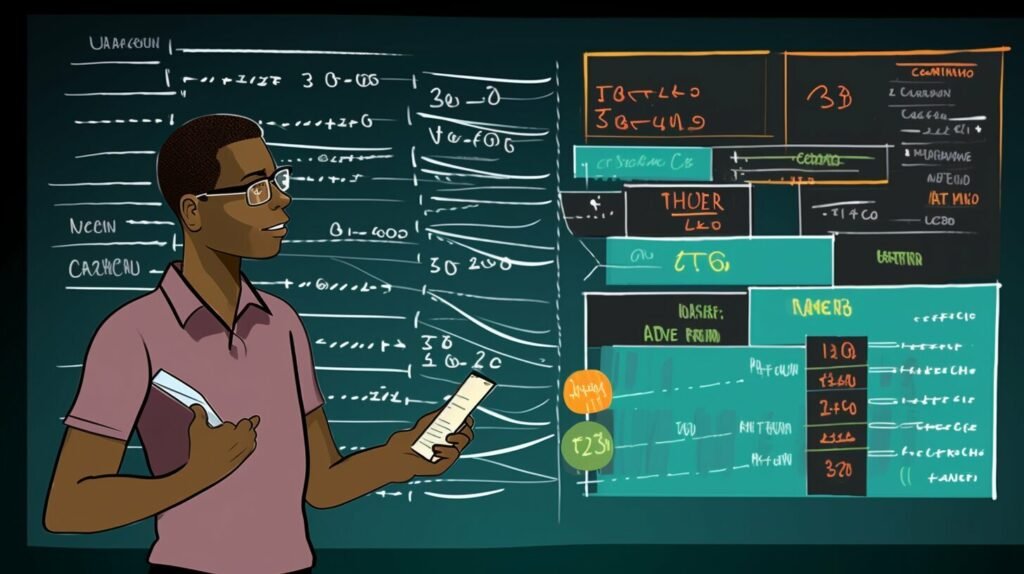Welcome to our simple guide on variables and data types in programming, where we explore the fundamental concepts that will empower your coding skills. Variables are names associated with memory locations in a computer where values can be stored. In Java, there are primitive variables that hold primitive types and object or reference variables that hold references to objects of a class. Primitive types in Java include int (for integers), double (for floating point numbers), boolean (for Boolean values), and String (for a sequence of characters). To declare a variable in Java, you specify the type and name of the variable. The type determines how many bits are allocated to store the value. Variables can be assigned values using the equals sign (=). Arrays, or lists, are used to store collections of data items. They can hold items of the same type and are defined using square brackets. Objects in programming represent things like pets, customers, or blog posts. They group related properties together in a custom data type. Properties are defined and assigned values using object literal syntax. In Python, variables are containers that store information. They don’t need explicit type declarations and can hold different types of data. Python’s built-in data types include numbers, strings, booleans, lists, tuples, and dictionaries. When naming variables, it’s important to use descriptive names and follow naming conventions. Python convention uses snake_case for variable names. Examples of using variables in Python include temperature conversion, user input and conditionals, and creating and manipulating a shopping list. By understanding variables and data types, you can effectively store and manipulate data in your programs.
Key Takeaways:
- Variables are names associated with memory locations where values can be stored.
- Java has primitive variables and object or reference variables.
- Primitive types in Java include int, double, boolean, and String.
- Arrays are used to store collections of data items in Java.
- Objects group related properties together in a custom data type.
- Python variables don’t need explicit type declarations and can hold different types of data.
- Python’s built-in data types include numbers, strings, booleans, lists, tuples, and dictionaries.
- Descriptive names and naming conventions are important when naming variables.
- Understanding variables and data types allows effective storage and manipulation of data in programming.
Understanding Variable Definition and Declaration
In programming, proper variable definition and declaration are crucial for effectively storing and accessing data. Let’s explore the process of defining and declaring variables in different programming languages.
In Java, variables are declared by specifying the type and name of the variable. This informs the compiler how much memory to allocate for the variable. For example, to declare an integer variable named “count”, we would write:
int count;Here, “int” is the data type and “count” is the variable name. We can then assign a value to the variable using the equals sign (=). For instance:
count = 10;On the other hand, Python does not require explicit variable declarations. You can assign a value to a variable directly, and its type is determined dynamically. For example:
count = 10With this syntax, Python automatically decides the data type based on the assigned value.
Example
Let’s take a look at a practical example of variable definition and declaration in Python:
# Define a variable
name = "John Doe"
# Print the variable value
print(name)
# Update the variable value
name = "Jane Smith"
# Print the updated value
print(name)In this example, we define a variable called “name” and assign it the string value “John Doe”. We then print the value of the variable, which will output “John Doe” to the console. Next, we update the value of the variable to “Jane Smith” and print the updated value, which will output “Jane Smith”.
By understanding how to define and declare variables in different programming languages, you can effectively store and access data in your programs.
| Language | Variable Definition | Variable Declaration |
|---|---|---|
| Java | Type + Name | int count; |
| Python | Name + Value Assignment | count = 10 |
Mastering Variable Assignment
Once variables are declared, the next step is to assign values to them. Let’s dive into the process of variable assignment and understand the nuances in different programming languages.
In Java, variable assignment is straightforward. You simply use the equals sign (=) to assign a value to a variable. For example, let’s say we have a variable called “age” and we want to assign it the value 25:
| Java |
|---|
| int age = 25; |
On the other hand, Python offers more flexibility when it comes to variable assignment. You can assign different types of data to a variable without explicitly declaring its type. For example, in Python, you can assign an integer to a variable and later assign a string to the same variable:
| Python |
|---|
| age = 25 |
| age = “twenty-five” |
This dynamic nature of variable assignment in Python allows for greater flexibility and ease of use.
Understanding variable assignment is crucial in programming, as it allows you to store and manipulate data effectively. Whether you’re working with Java or Python, grasping the nuances of variable assignment will enhance your coding skills and help you build more robust and efficient programs.
Exploring Integer Data Type
Integer data type plays a fundamental role in programming, allowing us to work with whole numbers. Let’s explore the intricacies of the integer data type in different programming languages.
In Java, the integer data type is represented by the int keyword. It allocates 32 bits of memory to store whole numbers. The range of values that can be stored in an int variable is -2,147,483,648 to 2,147,483,647. We can perform basic arithmetic operations such as addition, subtraction, multiplication, and division using the int data type. For example:
int num1 = 5;
int num2 = 10;
int sum = num1 + num2;
System.out.println("The sum is: " + sum);
In Python, integers are represented by the int data type. Unlike Java, Python does not have a limit on the size of integers. It automatically allocates memory based on the size of the integer. We can perform arithmetic operations on integers in Python as well. For example:
num1 = 5
num2 = 10
sum = num1 + num2
print("The sum is:", sum)
Here, we have explored the integer data type in both Java and Python. Understanding how to work with whole numbers is essential in programming, as it forms the foundation for more complex calculations and algorithms.
| Language | Integer Data Type | Range of Values |
|---|---|---|
| Java | int | -2,147,483,648 to 2,147,483,647 |
| Python | int | No limit |
Understanding String Data Type
Strings are essential for working with textual data in programming. Let’s delve into the characteristics and functionalities of the string data type across different programming languages.
In Java, strings are objects of the String class. They are enclosed in double quotes and can contain letters, numbers, and special characters. Strings in Java are immutable, meaning they cannot be changed once created. This ensures the integrity of the data stored in them.
Python, on the other hand, treats strings as a combination of characters enclosed in either single or double quotes. Unlike Java, strings in Python are mutable, which allows for easier manipulation and modification of the data stored in them.
Both Java and Python provide a wide range of built-in functions and methods to perform operations on strings. These include concatenation, slicing, length calculation, and case conversion. For example, in Python, the len() function is used to determine the length of a string, while in Java, the length() method is used for the same purpose.
| Programming Language | String Data Type |
|---|---|
| Java | String |
| Python | str |
Understanding the characteristics and functionalities of the string data type is crucial for handling and manipulating textual data in programming. Whether you’re using Java or Python, mastering string operations and methods will enhance your coding skills and enable you to effectively work with strings.
Exploring Float Data Type
When it comes to dealing with decimal numbers, the float data type offers precision and flexibility. Let’s deep dive into the float data type in different programming languages and uncover its nuances.
In Java, the float data type is used to represent single-precision floating point numbers. It is denoted by the keyword “float” and can store values with up to 7 decimal digits. The range of values that can be stored as floats is approximately ±3.40282347E+38. Floats are commonly used in scientific and mathematical computations where precision is important.
Python, on the other hand, uses the “float” data type to represent both single-precision and double-precision floating point numbers. Python automatically assigns a float data type to any number with a decimal point. The range of values that can be stored as floats in Python is virtually unlimited, allowing for precise calculations and handling of large numbers.
When working with floating point numbers, it’s important to be aware of the potential for rounding errors due to the finite precision of the float data type. This can lead to unexpected results in certain calculations. To mitigate this, programming languages provide functions and methods for rounding and formatting floating point numbers.
To summarize, the float data type is essential for handling decimal numbers in programming. It provides precision and flexibility in representing and manipulating floating point values. Understanding how floats are implemented in different programming languages is crucial for accurate calculations and reliable code.
| Programming Language | Float Data Type | Range |
|---|---|---|
| Java | float | -3.40282347E+38 to +3.40282347E+38 |
| Python | float | Approximately ±1.7976931348623157E+308 |
Understanding Boolean Data Type
Boolean data type is a core component of decision-making in programming. Let’s unravel the power of boolean data type and its applications across different programming languages.
In programming, boolean data type represents two possible values – true or false. It is essential for building logic and controlling the flow of a program. Boolean expressions are used in conditional statements, loops, and logical operations.
In Java, boolean variables are declared using the keyword “boolean”. They can only hold the values true or false. For example, you can use a boolean variable to check if a condition is true or false before executing a certain block of code. This allows you to create decision-making structures in your program.
In Python, boolean data type is represented by the keywords “True” and “False” (notice the capitalization). Python treats anything that evaluates to zero (like empty strings, lists, or zero integers) as False, and anything else as True. This flexibility in Python allows you to use boolean values in a variety of ways.
| Java | Python |
|---|---|
boolean isRaining = true;
boolean isSunny = false;
|
is_raining = True
is_sunny = False
|
Understanding boolean data type and its applications is crucial for writing effective programs. By using boolean variables and expressions, you can make decisions and control the flow of your code. Whether you’re writing in Java or Python, mastering the boolean data type will enhance your programming skills.
Exploring Array Data Type
Arrays provide a powerful way to store and manipulate collections of data in programming. Let’s dive into the intricacies of arrays and uncover their implementation in different programming languages.
In Java, arrays are declared using square brackets and can hold multiple values of the same data type. For example, to declare an integer array named ‘numbers’ that can hold 5 values, you would use the following syntax:
int[] numbers = new int[5];
Once an array is declared, you can access individual elements using their index. The index starts from 0 for the first element and increments by 1 for each subsequent element. To assign a value to an element in the array, you would use the following syntax:
numbers[0] = 10;
Python also supports arrays, which are referred to as lists in the language. Lists can hold values of different data types and are declared using square brackets. To declare a list in Python named ‘fruits’ that contains strings, you would use the following syntax:
fruits = ['apple', 'banana', 'orange'];
Similar to Java arrays, Python lists can be accessed using their index. However, Python uses zero-based indexing, so the first element has an index of 0. To access an element in the list, you would use the following syntax:
print(fruits[0]);
Array Example
Let’s take a look at an example that demonstrates the use of arrays in Java:
public class ArrayExample {
public static void main(String[] args) {
int[] numbers = new int[5];
numbers[0] = 10;
numbers[1] = 20;
numbers[2] = 30;
numbers[3] = 40;
numbers[4] = 50;
System.out.println(numbers[2]); // Output: 30
}
}Summary
In programming, arrays are a fundamental data structure used for storing and manipulating collections of data. They provide a convenient way to organize data and access individual elements. Whether you’re working with Java or Python, understanding arrays is essential for building robust and efficient programs.
Conclusion
Congratulations! You have now gained a solid understanding of variables and data types in programming. By grasping these fundamental concepts, you are well-equipped to store and manipulate data effectively in your programs.
Variables are names associated with memory locations in a computer where values can be stored. In Java, there are primitive variables that hold primitive types and object or reference variables that hold references to objects of a class. Primitive types in Java include int (for integers), double (for floating point numbers), boolean (for Boolean values), and String (for a sequence of characters).
In Python, variables are containers that store information. They don’t need explicit type declarations and can hold different types of data. Python’s built-in data types include numbers, strings, booleans, lists, tuples, and dictionaries. When naming variables, it’s important to use descriptive names and follow naming conventions. Python convention uses snake_case for variable names.
By understanding variables and data types, you can effectively store and manipulate data in your programs. Examples of using variables in Python include temperature conversion, user input and conditionals, and creating and manipulating a shopping list.
FAQ
What are variables in programming?
Variables are names associated with memory locations where values can be stored.
What are primitive types in Java?
Primitive types in Java include int (for integers), double (for floating point numbers), boolean (for Boolean values), and String (for a sequence of characters).
How do you declare a variable in Java?
In Java, you declare a variable by specifying the type and name of the variable.
What are arrays used for?
Arrays are used to store collections of data items of the same type.
What are objects in programming?
Objects in programming represent things like pets, customers, or blog posts. They group related properties together in a custom data type.
What types of data can variables hold in Python?
Variables in Python can hold different types of data, including numbers, strings, booleans, lists, tuples, and dictionaries.
How should variables be named in Python?
It is important to use descriptive names and follow naming conventions. In Python, the convention is to use snake_case for variable names.
Can variables hold different types of data in Python?
Yes, variables in Python can hold different types of data without requiring explicit type declarations.
What are some examples of using variables in Python?
Examples include temperature conversion, user input and conditionals, and creating and manipulating a shopping list.
Why is it important to understand variables and data types?
Understanding variables and data types allows for effective storage and manipulation of data in programming.







